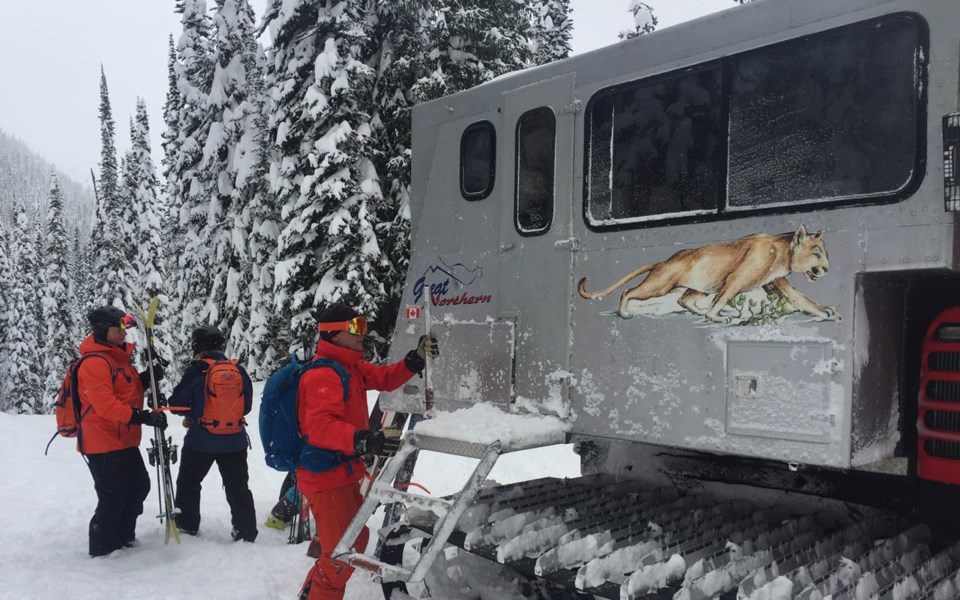The Trout Lake "snow machine" was cranking up its game. Mid-morning on my first day at Great Northern Snowcat Skiing, it was still snowing as hard as it had for the past 48 hours.
"This is classic South Selkirks," says lead guide Peter Harvey, looking into the billowing flakes. He should know, having worked as a guide with CMH Heli-Skiing and Summer Advenutres for 30 years. And then, after we finish a steep and very deep tree run at Adeco Point: "That was the best skiing of the year."
He's already said as much a few times, but from a guy who tends to be both sage and funny, you can tell he means it this time. The afternoon is a follow-the-leader romp through milk-bowl whiteouts, where Peter, at times, is thigh-deep breaking trail.
At the end of the day, we ski out through The Burn, a ridiculously fun descent where skiers' joyous audibles erupt like random speech balloons between blackened spires. When we hit the road, we have a choice of skiing 14 kilometres back to the lodge or taking the cat. My Whistler-honed "death before download" ethos dictates skiing the road. It's a great way to end the day—a contemplative schuss where you simply watch the mountain world go by with fresh air in your face and the smell of trees on your nose. I will do it every day.
It's a bright new chapter for a venerable operation that has flown under the radar for decades. The previous season, Brent McCorquodale, the Lake Louise ski instructor who'd established Great Northern in 1979, retired, passing the torch to a new group which also runs Mt. Norquay in Banff. While embracing everything that draws skiers back here season-after-season—family feel, laid-back vibe, small groups—the new owners are also making the kind of improvements crucial to enticing a new generation of skiers.
The potential here is huge, with terrain open that hasn't been used for years—and plenty more to develop. They're also running a second cat for day skiers booked through Revelstoke Mountain Resort, an hour-and-a-half away including a ferry ride across Arrow Lake.
After the ferry, you reach the lodge by driving through the community of Trout Lake. The hamlet once boasted 60 people but its economy crashed when weed was legalized in Washington state and two-thirds of residents left.
At the lodge, I'm greeted by manager Marie. She's sweet and efficient, bends over backwards for guests, and always has a hot sauna waiting at day's end. The food proves superb, the kind you scribble notes about so you can tell people about it later and recreate dishes at home. Once you settle around the dinner table, with staff and guides spread around among the guests, wine is poured and the stories start to flow.
Two of the more enduring characters I meet are father-son duo Brian and Walker Vietch. Brian lived all over the west—starting with Whistler in the 1970s, then eventually Mt. Washington for a spell before moving to Ontario to run Hidden Valley outside Huntsville for 17 years. He sent scion Walker out here in 2016 at the tender age of 19 to drive cat, then moved here himself in 2017 as operations manager, a job he began by gutting the lodge, taking out half of the deck, raising a sagging building, and refinishing everything inside.
On Day 2, the snowfall finally breaks on the cat ride up and by the top we can even see blue. The hour-long ride is a chance for real conversation and exchange. People discuss music and trade playlists over a guest's portable Bluetooth speaker. With a mix of Canucks and Yanks on hand, politics is staunchly avoided.
There was 30 centimetres of new snow on the board yesterday, and over 50 cm today. But the extra snow now makes things extra dangerous. Numerous avalanches are reported at backcountry operations around us, demanding extra caution.
The snow is so deep we're literally swimming the first run, and end up skiing the road. But even that's too much and the going is slow. We step up slowly with short, mellow runs, then mid-steeps, then longer, steeper, more complex lines while always keeping our eye on the stability.
Eventually it begins to clear, bringing good visibility and a temperature drop that tightens the snow. By the afternoon, everything is firing and we ski extremely deep but well-supported snow in the trees. At the end of the day, we ski the road again, though fewer join the posse.
No matter how worn out, however, no one misses the amazingness of our last day, which consists of some the best cat-skiing you can imagine—colder still with 6 cm of fluff atop a newly settled metre or more.
I don't remember much from that day, but a run with Peter down something called "Lone Pine" must have been exceptional, as when I check my notes later I see I wrote the name followed by three exclamation marks!!!—homage, it seems, to that Trout Lake snow machine.
Leslie Anthony is a Whistler-based author, editor, biologist and bon vivant who has never met a mountain he didn't like.



.jpg;w=120;h=80;mode=crop)
